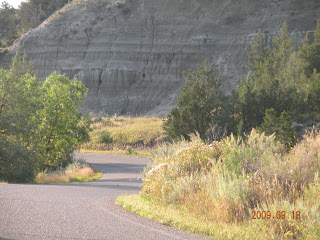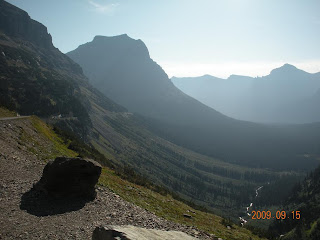Theodore Roosevelt National Park
This page is dedicated to Ted, who wondered why anyone would want to go to Theodore Roosevelt National Park. Though it was spread across two days, we spent a total of about one full day here, and will probably be back sometime. Knowing that we were running short on time, we rarely strayed very far from the car, but there were a few places we would have liked to explore a little further.Not being a historian, I don't know much about Teddy Roosevelt's politics, but I have come to respect the role that he played in preserving some of our country's greatest treasures, and in helping to get the National Park idea off the ground. It is fitting that he has a National Park that bears his name, and this location in the North Dakota badlands, where he once lived, is an appropriate place for this honor.
About the Park
The park actually has three disconnected units - the North Unit, the South Unit, and in between, the largely undeveloped original Elkhorn Ranch site
Those of us who love to see natural beauty are thankful that the best places for sightseeing are often the worst for commercial development. I don't know why the separate units of this park are spread so far apart, but I suspect it is because there is tillable or grazable land in between. The South Unit, being right on I-94, sees the most visitors. The North Unit is similar to the South, though there are some differences in the wildlife populations at the two areas. The Elkhorn Ranch unit is the actual site of Roosevelt's second ranch house, though the ranch buildings are no longer there, and it is pretty much undeveloped at this point. We did not stop at the ranch site, though we would have considered it if we had more time.North Unit
Most of the North Unit was closed for road construction when we were there. We could only drive as far as the campground and then back out. It's a good thing we weren't planning to camp here - it would have been a little tight getting the motorhome comfortably into one of the campsites, though we probably could have done it. We saw a good sized herd of buffalo near the campground, and another crossing the road on the way back.Painted Canyon Rest Stop
I-94 closely follows the southern border of the South Unit. At one point, the highway crosses a corner of the park. Painted Canyon is not only a regular highway rest area, with truck parking and everything, it is also a National Park Service visitor center. This area provided probably the best overall view of the North Dakota badlands.South Unit
We spent the night at a campground in Medora, a town near the entrance to the South Unit. Then we were up early again, to spend a few hours in the park before we hit the road again. We plan to go around the Scenic Loop Drive, which should take us to some of the highlights of the park.Prairie Dog Metropolis
There were several prairie dog towns along the road, some of which were quite large. It left me wondering if there was a shortage of natural predators. But they seemed fat and happy, so I don't suppose they were badly overpopulated.Buffalo Herd
This bison herd was crossing the road in front of us. At one point something scared them (not us, we were sitting still watching) and they started running, but still in the road. We were finally able to slowly weave our way past them. We took these pictures from the car as we drove by.More View from Along the Road
It may not be the mountains, but it has a beauty all its own.Coal Vein Trail
We took the road to the trailhead for the Coal Vein Trail. This would be an interesting walk to take someday - there was a coal vein that actually burned underground for several years. The trail highlights some of the changes resulting from that long burning. What we did see along this road was a herd of wild feral horses. I think this is the first time I had ever seen horses in the wild. This group seemed to be led by the white stallion you see in the third picture.More Wild Horses
A little further down the road, we saw another group of wild horses right on the road. This group was led by a black stallion.On The Road Again
 We bid farewell to Theodore Roosevelt National Park, and are back at the campground by 11 am to start the journey back to Illinois. The rest of the trip is fairly uneventful. We enjoyed the trip a lot, even though we packed a lot of miles and a lot of sights into a short two-week trip. The weather was wonderful, warm days and cool nights. The only time it rained was just a little ways before we got to Bloomington on the way back. This was just in time to soften the grime before we took the motorhome to the truck wash to get rid of about 4,000 miles of dirt and bugs.
We bid farewell to Theodore Roosevelt National Park, and are back at the campground by 11 am to start the journey back to Illinois. The rest of the trip is fairly uneventful. We enjoyed the trip a lot, even though we packed a lot of miles and a lot of sights into a short two-week trip. The weather was wonderful, warm days and cool nights. The only time it rained was just a little ways before we got to Bloomington on the way back. This was just in time to soften the grime before we took the motorhome to the truck wash to get rid of about 4,000 miles of dirt and bugs.








































































